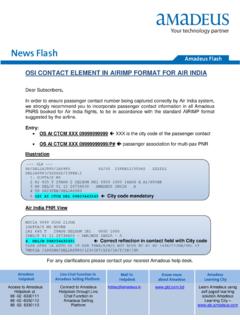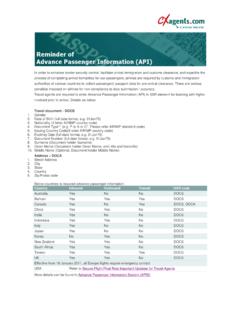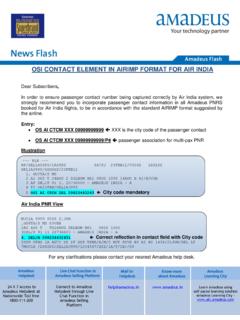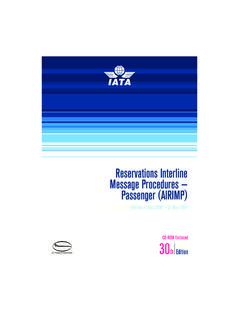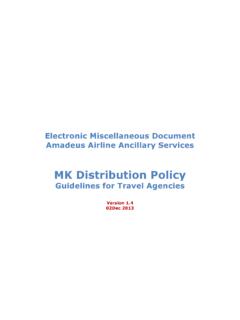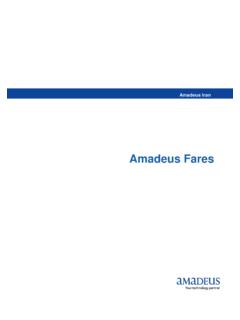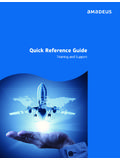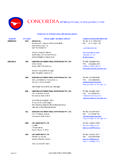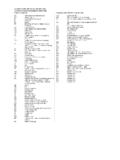Transcription of Unit 23: Aviation Communications
1 1 Aviation Communications Pearson BTEC Nationals (QCF) specifi cation in Aviation Operations Issue 2 November 2019 Pearson Education Limited 2012 Unit 23: Aviation CommunicationsUnit code: Y/601/6461 QCF Level 2: BTEC SpecialistCredit value: 4 Guided learning hours: 34 Aim and purposeThe aim of this unit is to enable the learner to develop the necessary knowledge and understanding of the principles of communication within Aviation . This will enable the learner to communicate relevant information, both formally and informally, to all relevant and interested parties. Accurate communication within the industry is knowledge gained from this unit is fundamental to all activities within the Aviation industry. This unit is appropriate for all learners prior to them undertaking activities at an airport regardless of specifi c introductionCommunication is much more than just talking. It assumes an exchange of information that is clear, accurate and understood correctly by both parties.
2 In the hectic environment frequently experienced in a busy airport, this is not always as straightforward as may be thought. Not only do learners need to examine types of communication and their uses but also how barriers to communication can cause inconvenience, delays, expense and even unsafe unit lends itself to the on-the-job training model. All the learning outcomes can be covered by learners working under supervision. In the classroom, there is great scope for role play as, of course, communication involves more than one person sometimes large people fi nd talking in public uncomfortable. Frequently, job roles within the Aviation industry require staff to speak with self-assurance, authority and diplomacy to members of the public and other staff . On completion of this unit, learners should have been given the opportunity to practise and strengthen their communication outcomesOn completion of this unit a learner should:1 Be able to carry out eff ective Aviation communications2 Be able to carry out eff ective transfer of Aviation information.
3 Aviation Communications Pearson BTEC Nationals (QCF) specifi cation in Aviation Operations Issue 2 November 2019 Pearson Education Limited 20122 Unit content1 Be able to carry out eff ective Aviation communicationsCommunicate: clear voice even pace steady volume correct wordingCommunication methods and systems: voice, phone, handheld radio, air to ground radio, public address (PA) system, tablets, drive unspoken, lights, hand signals, alarms written, email, SITA, SMS, manuals, fl ight information display system (FIDS), signs, noticeboard, aircraft loading documents, airline systems for loading or check inTerminology and accuracy: choice of words Civil Aviation Authority (CAA) radiotelephony manual phonetic alphabet reasons Interline Message Procedure potential outcomes of errors, confusion, delays, costs, safety breaches Protocols: standard radiotelephony (R/T) procedures ensure understanding confi rm understanding request clarifi cation use of jargon, for staff , passengers reference to airport and airline proceduresTime codes: local time Coordinated Universal Time (UTC) zulu elapsed time3 Aviation Communications Pearson BTEC Nationals (QCF) specifi cation in Aviation Operations Issue 2 November 2019 Pearson Education Limited 20122 Be able to carry out eff ective transfer of Aviation informationReceive and relay accurate information: receive, verbally, electronically, written record if necessary relay to appropriate people, passengers, staff awareness of confi dential and commercially sensitive informationReasons for storing Aviation Communications : audit evidence incident investigation Flight documents and appropriate persons.
4 Documents, passenger manifest, cargo manifest, AAA documents, loadsheets, boarding gate reports personnel, fl ight dispatcher, fl ight deck crew, loading supervisor, cabin crewTypes of information: fl ight departures fl ight delays special requests passenger numbers baggage loadsFailures in communication: causes, power failure, noisy environment, incorrect information implications, confusion to passengers and staff , incorrect actions, delays, costs, serious incidentsAviation Communications Pearson BTEC Nationals (QCF) specifi cation in Aviation Operations Issue 2 November 2019 Pearson Education Limited 20124 Assessment and grading criteriaIn order to pass this unit, the evidence that the learner presents for assessment needs to demonstrate that they can meet all the learning outcomes for the unit. The assessment criteria for a pass grade describe the level of achievement required to pass this and grading criteriaTo achieve a pass grade the evidence must show that the learner is able to:To achieve a merit grade the evidence must show that, in addition to the pass criteria, the learner is able to:To achieve a distinction grade the evidence must show that, in addition to the pass and merit criteria, the learner is able to.
5 P1 Communicate using correct communication methods and protocols [SM, EP]P2 Explain systems used for Aviation communicationM1 Compare the methods, systems and protocols used for communicating in diff erent Aviation situationsD1 Discuss how Aviation communication systems, methods and protocols ensure information is exchanged clearly and accuratelyP3 Identify communication methods used in aviationP4 Describe the terminology used in Aviation communicationP5 Explain the importance of accuracy in Aviation communicationP6 Identify protocols that should be adhered to when communicatingP7 Explain time-related codes relevant to aviationP8 Receive and relay appropriate and accurate information to appropriate persons [TW, SM, EP]M2 Transfer fl ight information to appropriate persons confi dently and accurately D2 Evaluate own performance when receiving and relaying fl ight information making recommendations for improvementP9 Explain the reasons for storing Aviation communicationP10 Identify the fl ight documents involved in the transfer of fl ight informationP11 Identify appropriate persons that require fl ight documents5 Aviation Communications Pearson BTEC Nationals (QCF) specifi cation in Aviation Operations Issue 2 November 2019 Pearson Education Limited 2012 Assessment and grading criteriaTo achieve a pass grade the evidence must show that the learner is able to:To achieve a merit grade the evidence must show that, in addition to the pass criteria, the learner is able to:To achieve a distinction grade the evidence must show that, in addition to the pass and merit criteria, the learner is able to.
6 P12 Identify the types of information that must be transferredP13 Explain the implications of failures in communicationPLTS: This summary references where applicable, in the square brackets, the elements of the personal, learning and thinking skills applicable in the pass criteria. It identifi es opportunities for learners to demonstrate eff ective application of the referenced elements of the independent enquirersCT creative thinkersRL refl ective learners TW team workersSM self-managersEP eff ective participatorsAviation Communications Pearson BTEC Nationals (QCF) specifi cation in Aviation Operations Issue 2 November 2019 Pearson Education Limited 20126 Essential guidance for tutorsDeliveryClear, accurate communication is fundamental to the safe and effi cient operation of any airport or airline. This is especially so during the high-pressure environment of the turnaround. Low-cost carriers have brought new benchmarks for reducing the amount of time an aircraft spends on the ground.
7 It is not uncommon for a 180-seat aircraft to arrive with a full load of passengers and baggage, disembark and reload with another full complement in less than 30 minutes. Without eff ective communication between colleagues, staff from other agencies and of course passengers, this would not be able to take place. It is necessary for learners not only to appreciate what good communication is, but also the barriers to, and consequences of, poor learners are able to listen to airband radios. If the centre is near an airport, a radio could be brought into class to monitor conversations between aircraft and air traffi c. This should provide an example of how eff ective communication between work colleagues. Learners can be challenged to interpret the message What did it mean? Why was it clear to the recipient? Was it clear and fully understood by a non- Aviation person? This highlights the danger of using jargon and the assumption of understanding. Learners could then be invited to devise their own series of Aviation -related messages which could be passed verbally to colleagues, ideally without seeing each other.
8 Peer assessment (overseen by the tutor) could be used to judge whether the message is clear and has been understood. During these practical activities, learners should use the phonetic alphabet and relevant Aviation terminology. While verbal communication is widely appreciated as a medium for conveying information instantly, most learners will also be familiar with non-spoken systems such as SMS (text) and email. This can be extended to include fl ight information display systems (FIDS). All of these are widely used in the Aviation industry. Systems such as reference books, notices or memos still have an important place in the communication armoury. Unspoken, unwritten means of communication are used in Aviation . Hand signals, signs and lights are frequently used in the airport should be encouraged to consider the diff erent types of information (urgent, routine, simple, complex) that need to be conveyed to a variety of recipients (staff , passengers, external agencies) and decide which medium is the most appropriate in each case.
9 For learners to work towards achieving the merit and distinction criteria tutors will need to create opportunities for them to fully explore the benefi ts and limitations of all systems, methods and protocols in diff erent Aviation communication situations. Some information must be stored the main reasons are included in the unit content. Usually these are written documents that will determine the communication method that must be used. Examples of documents should be produced to illustrate the diff erent types. Loadsheets, loading instructions, manifests and weather reports are typical of documents that must be stored. The transfer of fl ight information must be accurate, timely and communicated clearly between the relevant Aviation personnel in order for fl ights to depart safely and on time. Learners will need suffi cient time to practise receiving and relaying information throughout the duration of the unit. Tutors will need to provide a range of scenarios and if possible relevant equipment such as handheld radios.
10 Learners will need to observe the professional standards used within the Aviation environment when transferring fl ight information either by visiting a terminal, guest speakers or tutor demonstration. In conclusion, a group discussion could be used to explore the potential consequences of communication failures. To cover this fully, the topic should be broken down into three parts: 1) communication types; 2) barriers to eff ective communication; 3) potential consequences of poor learning plan7 Aviation Communications Pearson BTEC Nationals (QCF) specifi cation in Aviation Operations Issue 2 November 2019 Pearson Education Limited 2012 The outline learning plan has been included in this unit as guidance and can be used in conjunction with the programme of suggested outline learning plan demonstrates one way of planning the delivery and assessment of this unit. Topic and suggested assignments/activities and/assessmentIntroduction to the unit. Discussion of the aircraft turnaround and the diff erent situations requiring the communication of Aviation information and the environments in which this must take place.










